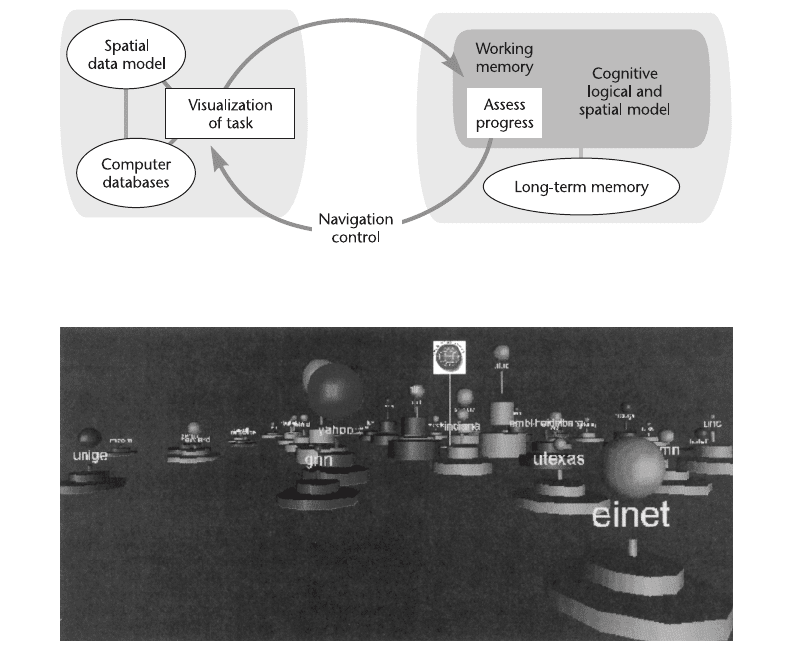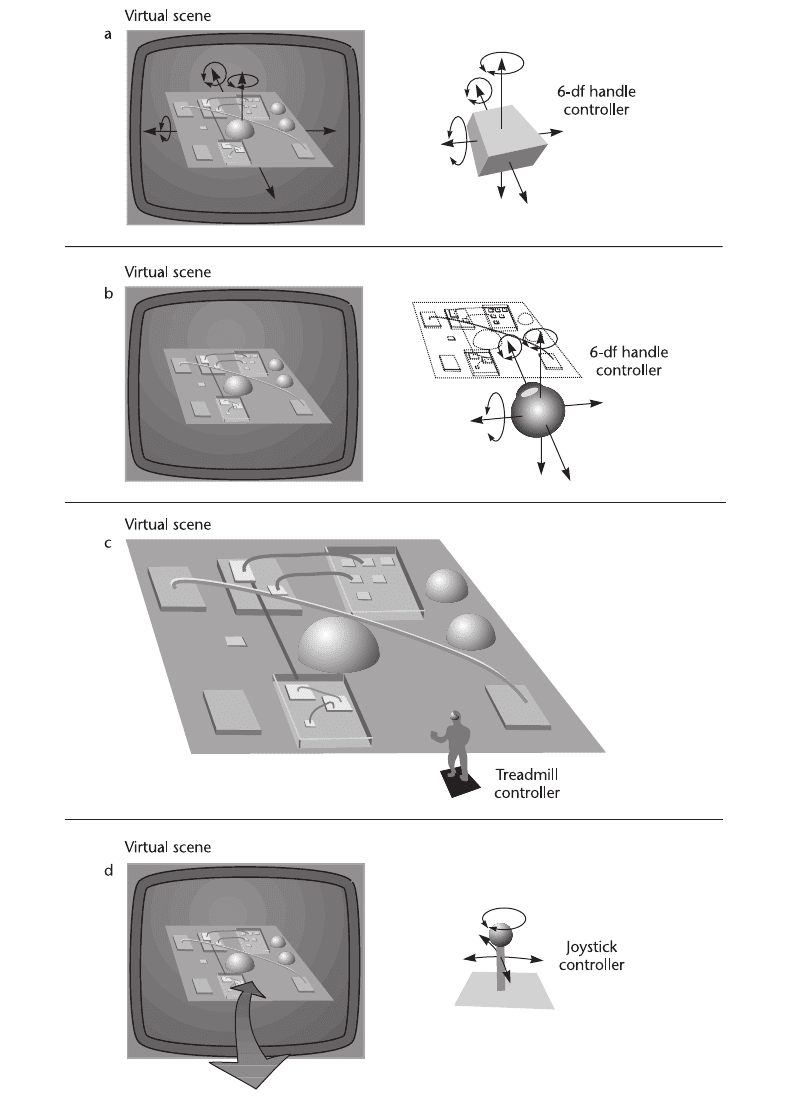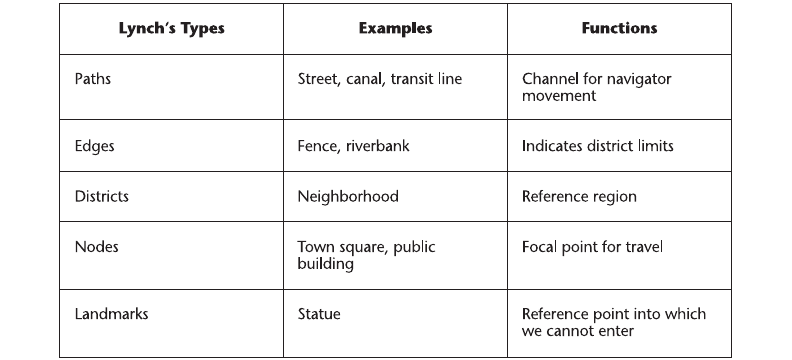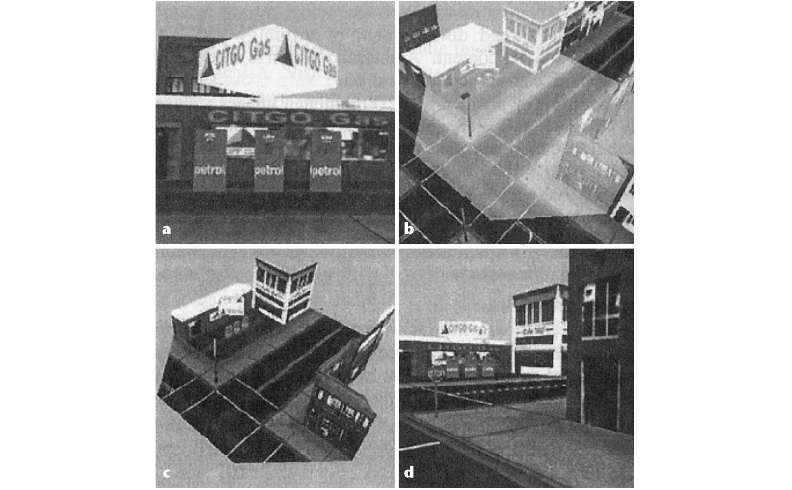Ware C. Information Visualization: Perception for Design
Подождите немного. Документ загружается.

than others. Very often we can make computer-mediated tasks easier to perform than their real-
world counterparts. When designing a house, we do not need to construct it virtually with bricks
and concrete. The magic of computers is that a single button click can often accomplish as much
as a prolonged series of actions in the real world. For this reason, it would be naïve to conclude
that computer interfaces should evolve toward VR simulations of real-world tasks or even
enhanced Go-Go Gadget–style interactions.
Vigilance
A basic element of many interaction cycles is the detection of a target. Although several aspects
of this have already been discussed in Chapter 5, a common and important problem remains to
be covered—the detection of infrequently appearing targets.
The invention of radar during World War II created a need for radar operators to monitor
radar screens for long hours, searching for visual signals representing incoming enemy aircraft.
Out of this came a need to understand how people can maintain vigilance while performing
monotonous tasks. This kind of task is common to airport baggage X-ray operators, industrial
quality-control inspectors, and the operators of large power grids. Vigilance tasks commonly
involve visual targets, although they can be auditory. There is extensive literature concerning
vigilance (see Davies and Parasuraman, 1980, for a detailed review). Here is an overview of some
of the more general findings, adapted from Wickens (1992):
1. Vigilance performance falls substantially over the first hour.
2. Fatigue has a large negative influence on vigilance.
3. To perform a difficult vigilance task effectively requires a high level of sustained attention,
using significant cognitive resources. This means that dual tasking is not an option during
an important vigilance task. It is not possible for operators to perform some useful task in
their “spare time” while simultaneously monitoring for some difficult-to-perceive signal.
4. Irrelevant signals reduce performance. The more irrelevant visual information is presented
to a person performing a vigilance task, the harder it becomes.
Overall, people perform poorly on vigilance tasks, but there are a number of techniques that can
improve performance. One method is to provide reminders at frequent intervals about what the
targets will look like. This is especially important if there are many different kinds of targets.
Another is to take advantage of the visual system’s sensitivity to motion. A difficult target for a
radar operator might be a slowly moving ship embedded in a great many irrelevant noise signals.
Scanlan (1975) showed that if a number of radar images are stored up and rapidly replayed, the
image of the moving ship can easily be differentiated from the visual noise. Generally, anything
that can transfer the visual signal into the optimal spatial or temporal range of the visual system
should help detection. If the signal can be made perceptually different or distinct from irrelevant
information, this will also help. The various factors that make color, motion, and texture dis-
tinct can all be applied. These are discussed in Chapters 4 and 5.
324 INFORMATION VISUALIZATION: PERCEPTION FOR DESIGN
ARE10 1/20/04 4:51 PM Page 324
Exploration and Navigation Loop
View navigation is important in visualization when the data is mapped into an extended and
detailed visual space. The problem is complex, encompassing theories of pathfinding and map
use, cognitive spatial metaphors, and issues related to direct manipulation and visual feedback.
Figure 10.2 sketches the basic navigation control loop. On the human side is a cognitive
logical and spatial model whereby the user understands the data space and his or her progress
through it. If the data space is maintained for an extended period, parts of its spatial model may
become encoded in long-term memory. On the computer side, the visualization may be updated
and refined from data mapped into the spatial model.
Here, we start with the problem of 3D locomotion; next, we consider the problem of
pathfinding, and finally move on to the more abstract problem of maintaining focus and context
in abstract data spaces.
Locomotion and Viewpoint Control
Some data visualization environments show information in such a way that it looks like a 3D
landscape, not just a flat map. This is done with remote sensing data from other planets, or with
maps of the ocean floor or other data related to the terrestrial environment. The data landscape
idea has also been applied to abstract data spaces such as the World Wide Web (see Figure 10.3
for an example). The idea is that we should find it easy to navigate through data presented in
this way because we can harness our real-world spatial interpretation and navigation skills.
James Gibson (1986) offers an environmental perspective on the problem of perceiving for
navigation:
A path affords pedestrian locomotion from one place to another, between the terrain
features that prevent locomotion. The preventers of locomotion consist of obstacles,
barriers, water margins, and brinks (the edges of cliffs). A path must afford footing; it
must be relatively free of rigid foot-sized obstacles.
Gibson goes on to describe the characteristics of obstacles, margins, brinks, steps, and slopes.
According to Gibson, locomotion is largely about perceiving and using the affordances offered
for navigation by the environment. (See Chapter 1 for a discussion of affordances). His per-
spective can be used in a quite straightforward way in designing virtual environments, much as
we might design a public museum or a theme park. The designer creates barriers and paths in
order to encourage visits to certain locations and discourage others.
We can also understand navigation in terms of the depth cues presented in Chapter 8. All
the perspective cues are important in providing a sense of scale and distance, although the stereo-
scopic cue is important only for close-up navigation in situations such as walking through a
crowd. When we are navigating at higher speed, in an automobile or a plane, stereoscopic depth
is irrelevant, because the important parts of the landscape are beyond the range of stereoscopic
Interacting with Visualizations 325
ARE10 1/20/04 4:51 PM Page 325

discrimination. Under these conditions, structure-from-motion cues and information based on
perceived objects of known size are critical.
It is usually assumed that smooth-motion flow of images across the retina is necessary for
judgment of the direction of self-motion within the environment. But Vishton and Cutting (1995)
investigated this problem using VR technology, with subjects moving through a forestlike virtual
environment, and concluded that relative displacement of identifiable objects over time was the
key, not smooth motion. Their subjects could do almost as well with a low frame rate, with images
presented only 1.67 times per second, but performance declined markedly when updates were less
than 1 per second. The lesson for the design of virtual navigation aids is that these environments
should be sparsely populated with discrete but separately identifiable objects—there must be
enough landmarks that several are always visible at any instant, and frame rates ideally should be
326 INFORMATION VISUALIZATION: PERCEPTION FOR DESIGN
Figure 10.3 Web sites arranged as a data landscape (T. Bray, 1996).
Figure 10.2 The navigation control loop.
ARE10 1/20/04 4:51 PM Page 326
at least 2 per second. However, it should also be recognized that although judgments of heading
are not impaired by low frame rates, other problems will result. Low frame rates cause lag in visual
feedback and, as discussed previously, this can introduce serious performance problems.
Spatial Navigation Metaphors
Interaction metaphors are cognitive models for interaction that can profoundly influence the
design of interfaces to data spaces. Here are two sets of instructions for different viewpoint
control interfaces:
1. “Imagine that the model environment shown on the screen is like a real model mounted
on a special turntable that you can grasp, rotate with your hand, move sideways, or pull
towards you.”
2. “Imagine that you are flying a helicopter and its controls enable you to move up and
down, forward and back, left and right.”
With the first interface metaphor, if the user wishes to look at the right-hand side of some part
of the scene, she must rotate the scene to the left to get the correct view. With the second inter-
face metaphor, the user must fly her vehicle forward, around to the right, while turning in toward
the target. Although the underlying geometry is the same, the user interface and the user’s con-
ception of the task are very different in the two cases.
Navigation metaphors have two fundamentally different kinds of constraints on their use-
fulness. The first of these constraints is essentially cognitive. The metaphor provides the user with
a model that enables the prediction of system behavior given different kinds of input actions. A
good metaphor is one that is apt, matches the system well, and is also easy to understand. The
second constraint is more of a physical limitation. A particular metaphor will naturally make
some actions physically easy to carry out, and others difficult to carry out, because of its imple-
mentation. For example, a walking metaphor limits the viewpoint to a few feet above ground
level and the speed to a few meters per second. Both kinds of constraints are related to Gibson’s
concept of affordances—a particular interface affords certain kinds of movement and not others,
but it must also be perceived to embody those affordances.
Note that, as discussed in Chapter 1, we are going beyond Gibson’s view of affordances here.
Gibsonian affordances are properties of the physical environment. In computer interfaces, the
physical environment constitutes only a small part of the problem, because most interaction is
mediated through the computer and Gibson’s concept as he framed it does not strictly apply. We
must extend the notion of affordances to apply to both the physical characteristics of the user
interface and the representation of the data. A more useful definition of an interface with the
right affordances is one that makes the possibility for action plain to the user and gives feedback
that is easy to interpret.
Four main classes of metaphors have been employed in the problem of controlling the view-
point in virtual 3D spaces. Figure 10.4 provides an illustration and summary. Each metaphor has
a different set of affordances.
Interacting with Visualizations 327
ARE10 1/20/04 4:51 PM Page 327

Figure 10.4 Four different navigation metaphors: (a) World-in-hand. (b) Eyeball-in-hand. (c) Walking. (d) Flying.
ARE10 1/20/04 4:51 PM Page 328
1. World-in-hand. The user metaphorically grabs some part of the 3D environment and
moves it (Houde, 1992; Ware and Osborne, 1990). Moving the viewpoint closer to some
point in the environment actually involves pulling the environment closer to the user.
Rotating the environment similarly involves twisting the world about some point as if it
were held in the user’s hand. A variation on this metaphor has the object mounted on a
virtual turntable or gimbal. The world-in-hand model would seem to be optimal for
viewing discrete, relatively compact data objects, such as virtual vases or telephones. It
does not provide affordances for navigating long distances over extended terrains.
2. Eyeball-in-hand. In the eyeball-in-hand metaphor, the user imagines that she is directly
manipulating her viewpoint, much as she might control a camera by pointing it and
positioning it with respect to an imaginary landscape. The resulting view is represented on
the computer screen. This is one of the least effective methods for controlling the
viewpoint. Badler et al. (1986) observed that “consciously calculated activity” was
involved in setting a viewpoint. Ware and Osborne (1990) found that although some
viewpoints were easy to achieve, others led to considerable confusion. They also noted
that with this technique, physical affordances are limited by the positions in which the
user can physically place her hand. Certain views from far above or below cannot be
achieved or are blocked by the physical objects in the room.
3. Walking. One way of allowing inhabitants of a virtual environment to navigate is simply
to let them walk. Unfortunately, even though a large extended virtual environment can be
created, the user will soon run into the real walls of the room in which the equipment is
housed. Most VR systems require a handler to prevent the inhabitant of the virtual world
from tripping over the real furniture. A number of researchers have experimented with
devices like exercise treadmills so that people can walk without actually moving. Typically,
something like a pair of handlebars is used to steer. In an alternative approach, Slater et
al. (1995) created a system that captures the characteristic up-and-down head motion that
occurs when people walk in place. When this is detected, the system moves the virtual
viewpoint forward in the direction of head orientation. This gets around the problem of
bumping into walls, and may be useful for navigating in environments such as virtual
museums. However, the affordances are still restrictive.
4. Flying. Modern digital terrain visualization packages commonly have fly-through
interfaces that enable users to smoothly create an animated sequence of views of the
environment. Some of these are more literal, having aircraftlike controls. Others use the
flight metaphor only as a starting point. No attempt is made to model actual flight
dynamics; rather, the goal is to make it easy for the user to get around in 3D space in a
relatively unconstrained way. For example, we (Ware and Osborne 1990) developed a
flying interface that used simple hand motions to control velocity. Unlike real aircraft, this
interface makes it as easy to move up, down, or backward as it is to move forward. They
reported that subjects with actual flying experience had the most difficulty; because of
Interacting with Visualizations 329
ARE10 1/20/04 4:51 PM Page 329
their expectations about flight dynamics, pilots did unnecessary things such as banking on
turns and were uncomfortable with stopping or moving backward. Subjects without flying
experience were able to pick up the interface more rapidly. Despite its lack of realism, this
was rated as the most flexible and useful interface when compared to others based on the
world-in-hand and eyeball-in-hand metaphors.
The optimal navigation method depends on the exact nature of the task. A virtual walking inter-
face may be the best way to give a visitor a sense of presence in an architectural space; some-
thing loosely based on the flying metaphor may be a more useful way of navigating through
spatially extended data landscapes. The affordances of the virtual data space, the real physical
space, and the input device all interact with the mental model of the task that the user has
constructed.
Wayfinding, Cognitive, and Real Maps
In addition to the problem of moving through an environment in real time, there is the metalevel
problem of how people build up an understanding of larger environments over time. This problem
is usually called wayfinding. It encompasses both the way in which people build mental models
of extended spatial environments and the way they use physical maps as aids to navigation.
Unfortunately, this area of research is plagued with a diversity of terminology. Throughout
the following discussion, bear in mind that there are two clusters of concepts, and the differences
between these clusters relate to the dual coding theory discussed in Chapter 9.
One cluster includes the related concepts of declarative knowledge, procedural knowledge,
topological knowledge, and categorical representations. These concepts are fundamentally logical
and nonspatial.
The other cluster includes the related concepts of spatial cognitive maps and coordinate rep-
resentations. These are fundamentally spatial.
Seigel and White (1975) proposed that there are three stages in the formation of wayfind-
ing knowledge. First, information about key landmarks is learned; initially there is no spatial
understanding of the relationships between them. This is sometimes called declarative knowl-
edge. We might learn to identify a post office, a church, and the hospital in a small town.
Second, procedural knowledge about routes from one location to another is developed.
Landmarks function as decision points. Verbal instructions often consist of procedural statements
related to landmarks, such as “Turn left at the church, go three blocks, and turn right by the gas
station.” This kind of information also contains topological knowledge, because it includes con-
necting links between locations. Topological knowledge has no explicit representation of the
spatial position of one landmark relative to another.
Third, a cognitive spatial map is formed. This is a representation of space that is two-dimen-
sional and includes quantitative information about the distances between the different locations
of interest. With a cognitive spatial map, it is possible to estimate the distance between any two
points, even though we have not traveled directly between them, and to make statements such
as “The university is about one kilometer northwest of the train station.”
330 INFORMATION VISUALIZATION: PERCEPTION FOR DESIGN
ARE10 1/20/04 4:51 PM Page 330
In Seigel and White’s initial theory and in much of the subsequent work, there has been a
presumption that spatial knowledge developed strictly in the order of these three stages: declar-
ative knowledge, procedural knowledge, and cognitive spatial maps. Recent evidence from a
study by Colle and Reid (1998) contradicts this. They conducted an experimental study using a
virtual building consisting of a number of rooms connected by corridors. The rooms contained
various objects. In a memory task following the exploration of the building, subjects were found
to be very poor at indicating the relative positions of objects located in different rooms, but they
were good at indicating the relative positions of objects within the same room. This suggests that
cognitive spatial maps form easily and rapidly in environments where the viewer can see every-
thing at once is the case for objects within a single room. It is more likely that the paths from
room to room were captured as procedural knowledge. The practical application of this is that
overviews should be provided wherever possible in extended spatial information spaces.
The results of Colle and Reid’s study fit well with a somewhat different theory of spatial
knowledge proposed by Kosslyn (1987). He suggested that there are only two kinds of knowl-
edge, not necessarily acquired in a particular order. He called them categorical and coordinate
representations. For Kosslyn, categorical information is a combination of both declarative knowl-
edge and topological knowledge, such as the identities of the landmarks and the paths between
them. Coordinate representation is like the cognitive spatial map proposed by Seigel. A spatial
coordinate representation would be expected to arise from the visual imagery obtained with an
overview. Conversely, if knowledge were constructed from a sequence of turns along corridors
when the subject was moving from room to room, the natural format would be categorical.
Landmarks provide the links between categorical and spatial coordinate representations.
They are important both for cognitive spatial maps and for topological knowledge about routes.
Vinson (1999) created a generalized classification of landmarks based on Lynch’s classification
(1960) of the “elements” of cognitive spatial maps. Figure 10.5 summarizes Vinson’s design
guidelines for the different classes of landmarks. This broad concept includes paths between loca-
tions, edges of geographical regions, districts, nodes such as public squares, and the conventional
ideal of a point landmark such as a statue.
Vinson also created a set of design guidelines for landmarks in virtual environments. The
following rules are derived from them:
•
There should be enough landmarks that a small number are visible at all times.
•
Each landmark should be visually distinct from the others.
•
Landmarks should be visible and recognizable at all navigable scales.
•
Landmarks should be placed on major paths and at intersections of paths.
Creating recognizable landmarks in 3D environments can be difficult because of multiple view-
points. Darken et al. (1998) reported that Navy pilots typically fail to recognize landmark terrain
features on a return path, even if these were identified correctly on the outgoing leg of a
low-flying exercise. This suggests that terrain features are not encoded in memory as fully three-
Interacting with Visualizations 331
ARE10 1/20/04 4:51 PM Page 331

dimensional structures, but rather are remembered in some viewpoint-dependent fashion. (See
Chapter 7 for a discussion of viewpoint-dependent object memory.)
An interesting way to assist users in the encoding of landmarks for navigation in 3D envi-
ronments was developed by Elvins et al. (1997). They presented subjects with small 3D subparts
of a virtual cityscape that they called worldlets, as illustrated in Figure 10.6. The worldlets pro-
vided 3D views of key landmarks, presented in such a way that observers could rotate them to
obtain a variety of views. Subsequently, when they were tested in a navigation task, subjects who
had been shown the worldlets performed significantly better than subjects who had been given
pictures of the landmarks, or subjects who had simply been given verbal instructions.
Cognitive maps can also be acquired directly from an actual map much more rapidly than
by traversing the terrain. Thorndyke and Hayes-Roth (1982) compared people’s ability to judge
distances between locations in a large building. Half of them had studied a map for half an hour
or so, whereas the other half never saw a map but had worked in the building for many months.
The results showed that for estimating the straight-line Euclidean distance between two points,
a brief experience with a map was equivalent to working in the building for about a year.
However, for estimating the distance along the hallways, the people with experience in the build-
ing did the best.
To understand map-reading skills, Darken and Banker (1998) turned to orienteering, a sport
that requires athletes to run from point to point over rugged and often difficult terrain with the
aid of a map. Experienced orienteers are skilled map readers. One cognitive phenomenon the
researchers observed was related to an initial scaling error rapidly remedied; they observed that
“initial confusion caused by a scaling error is followed by a ‘snapping’ phenomenon where the
332 INFORMATION VISUALIZATION: PERCEPTION FOR DESIGN
Figure 10.5 The functions of different kinds of landmarks in a virtual environment. Adapted from Vinson (1999).
ARE10 1/20/04 4:51 PM Page 332

world that is seen is instantaneously snapped into congruence with the mental representation”
(Darken et al., 1998). This suggests that wherever possible, aids should be given to identify match-
ing points on both an overview map and a focus map.
Frames of Reference
The ability to generate and use something cognitively analogous to a map can be thought of as
applying another perspective or frame of reference to the world. A map is like a view from above.
Cognitive frames of reference are often classified into egocentric and exocentric. According to
this classification, a map is just one of many exocentric views—views that originate outside of
the user.
The egocentric frame of reference is, roughly speaking, our subjective view of the world. It
is anchored to the head or torso, not the direction of gaze (Bremmer et al., 2001). Our sense of
what is ahead, left, and right does not change as we rapidly move our eyes around the scene,
but it does change with body and head orientation.
Interacting with Visualizations 333
Figure 10.6 Elvins et al. (1998) conceived the idea of worldlets as navigation aids. Each worldlet is a 3D
representation of a landmark in a spatial landscape. (a) A straight-on view of the landmark. (b) The region
extracted to create the worldlet. (c) The worldlet from above. (d) The worldlet from street level. Worldlets
can be rotated to facilitate later recognition from an arbitrary viewpoint.
ARE10 1/20/04 4:51 PM Page 333
